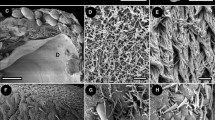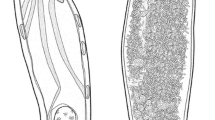Abstract
New collections were made of Ditrachybothridium macrocephalum Rees, 1959 from the deep-sea elasmobranchs Apristurus laurussonii (Saemundsson) and cf. Rajella bigelowi (Stehmann) in the northern Atlantic Ocean, allowing studies of the morphology of its plerocercus. The material has also allowed an estimate of its position within the Diphyllidea inferred from molecular data for the first time. The plerocercus is withdrawn, but not invaginated, within a cyst with a thick vacuolated wall. The encysted strobila is distinct, with several putative segments and advanced genital anlagen, and the scolex is fully developed with a distinct apical pad. 28S rDNA (D1-D3 regions) sequences were generated from both encysted and excysted D. macrocephalum, as well as from other diphyllidean and pseudophyllidean (outgroup) taxa for use in phylogenetic analyses. Maximum parsimony and Bayesian inference analyses both showed that the diphyllidean genus Echinobothrium is paraphyletic without inclusion of the only two other diphyllidean genera, Ditrachybothridium Rees, 1959 and Macrobothridium Khalil & Abdul-Salam, 1989. A list of published records of larval diphyllideans, their hosts and localities is included.
Similar content being viewed by others
References
Anantaraman, S. (1963) On the larva of Echinobothrium Beneden 1849 (Cestoda: Diphyllidea) in marine gastropods and a decapod of Madras. Zeitschrift für Parasitenkunde, 23, 315–319.
Beveridge, I. (2001) The use of life-cycle characters in studies of the evolution of cestodes. In:Littlewood, D.T.J. & Bray, R.A. Eds) Interrelationships of the Platyhelminthes. London: Taylor & Francis, pp. 250–256.
Brickle, P., Olson, P.D., Littlewood, D.T.J., Bishop, A. & Arkhipkin, A. (2001) Parasites of Loligo gahi from waters off the Falkland Islands with a molecular-based identification of their cestode larvae. Canadian Journal of Zoology, 79, 2289–2296.
Caira, J.N., Jensen, K. & Healy, C.J. (1999) On the phylo-genetic relationships among tetraphyllidean, lecanicephalidean and diphyllidean tapeworm genera. Systematic Parasitology, 42, 77–151.
Caira, J.N., Jensen, K. & Healy, C.J. (2001) Interrelationships among tetraphyllidean and lecanicephalidean cestodes. In:Littlewood, D.T.J. & Bray, R.A. (Eds) Interrelationships of the Platyhelminthes. plLondon: Taylor & Francis, pp. 135–158.
Cake, E.W., Jr (1976) A key to larval cestodes of shallow-water, benthic mollusks of the northern Gulf of Mexico. Proceedings of the Helminthological Society of Washington, 43, 160–171.
Chervy, L. (2002) The terminology of larval cestodes or metacest-odes. Systematic Parasitology, 52, 1–33.
Dollfus, R.-P. (1964) Sur le cycle évolutif d'un cestode diphyllide. Identification de la larve chez Carcinus maenas (L. 1758), hôte intermédiaire. Annales de Parasitologie Humaine et Comparée, 39, 235–241.
Faliex, E., Tyler, G. & Euzet, L. (2000) A new species of Ditrachy-bothridium (Cestoda: Diphyllidea) from Galeus sp. (Selachii, Scyliorhynidae) from the south Pacific Ocean, with a revision of the diagnosis of the order, family, and genus and notes on descriptive terminology of microtriches. Journal of Parasitology, 86, 1078–1084.
Huelsenbeck, J.P. & Ronquist, F. (2001) MRBAYES: Bayesian inference of phylogenetic trees. Bioinformatics, 17, 754–755.
Ivanov, V.A. & Hoberg, E.P. (1999) Preliminary comments on a phylogenetic study of the order Diphyllidea van Beneden in Carus, 1863. Systematic Parasitology, 42, 21–27.
Jones, M.K. & Beveridge, I. (2001) Echinobothrium chisholmae n. sp. (Cestoda, Diphyllidea) from the giant shovel-nose ray Rhinobatos typus from Australia, with observations on the ul-trastructure of its scolex musculature and peduncular spines. Systematic Parasitology, 50, 41–52.
Kunstler, J. (1888) Sur de nouveaux vers remarquables. Comptes Rendus des Séances de l'Académie des Sciences, 106, 553–554.
Lespés, C. (1857) Note sur une nouvelle espèce du genre Echino-bothrium. Annales des Sciences Naturelles. Zoologie,Série 3,7, 118–119.
Leuckart, R. & Pagenstecher, A. (1858) Untersuchungen über niedere Seethiere. Archiv für Anatomie, Physiologie und Wis-senschaftliche Medicin, (1858), 558–613.
Maddison, D.R. & Maddison, W.P. (2002) MacClade 4: Analysis of phylogeny and character evolution. Sunderland, Massachusetts: Sinauer AssociatFr, Inc.
Monticelli, F.S. (1890) Elenco degli elminti studiati a Wimereux nella primavera del 1889. Bulletin Scientifique de la France et de la Belgique,Série 4,22, 417–444.
Olson, P.D., Cribb, T.H., Tkach, V.V., Bray, R.A. & Littlewood, D.T.J. (2003) Phylogeny and classification of the Digenea (Platy-helminthes: Trematoda). International Journal for Parasitology, 33, 733–755.
Olson, P.D., Littlewood, D.T.J., Bray, R.A. & Mariaux, J. (2001) Interrelationships and evolution of the tapeworms (Platyhelmin-thes: Cestoda). Molecular Phylogenetics and Evolution, 19, 443–467.
Ostrowski de NÚñez, M. (1971) Estudios preliminaires sobre la fauna parasitaria de algunos elasmobranquios del litoral bon-aerense, Mar del Plata, Argentina. I. Cestodes y trematodes de Psammobatis microps (Günther) y Zapteryx brevirostris (Müller y Henle).Physis, 30, 425–446.
Ramadevi, P. & Rao, K.H. (1974) The larva of Echinobothrium ree-sae Ramadevi, 1969 (Cestoda: Diphyllidea) from the body cavity of a pasiphaeid crustacean Leptochela aculeocaudata Paulson, 1875. Journal of Helminthology, 48, 129–131.
Rees, G. (1959) Ditrachybothridium macrocephalum gen. nov., sp. nov., a cestode from some elasmobranch fishes. Parasitology, 49, 191–209.
Reimer, L.W. (1975) Cestodenlarven in Wirbellosen der Küste von Madras. Angewandte Parasitologie, 16, 1–16.
Reyda, F.B. & Olson, P.D. (2003) Cestodes of cestodes of Peruvian freshwater stingrays. Journal of Parasitology, 89, 1018–1024.
Ruszkowski, J.S. (1928) Etudes sur le cycle évolutif et sur la struc-ture des cestodes de mer. I. – Echinobothrium benedeni n. sp., ses larves et son hôte intermédiaire Hippolyte varians Leach. Bul-letin de l'Académie Polonaise des Sciences et des Lettres Classe des Sciences Mathématiques et Naturelles, Série B: Sciences Naturelles, 7, 719–738.
Schmidt, G.D. (1970) How to know the tapeworms. Dubuque, Iowa: William C. Brown Company Publishers, 266 pp.
Shimazu, T. (1975) [On the parasitic organisms in a krill, Euphausia similis, from Suruga Bay. V. Larval cestodes.] Japanese Journal of Parasitology, 24, 122–128. (In Japanese).
Shimazu, T. (1982) Some helminth parasites of marine planktonic invertebratFr. Journal of Nagano-ken Junior College, 37, 11–29.
Swofford, D.L. (2001) PAUP*. Phylogenetic analysis using parsi-mony (*and other methods). Version 4. Sunderland, Massachusetts: Sinauer AssociatFr.
van Beneden, P.J. (1858) Mémoire sur les vers intestinaux. Mémoire qui a obtenu de l'Institut de France (Académie des Sciences) le grand prix des Sciences physiques pour l'année 1853. Paris: J.B. Baillière. Reprinted in (1861) Compte Rendu Hebdomadaire des Seances de l'Académie des Sciences, Supplement 2, vii +376 pp.
Vivares, C.P. (1971) Etude des parasites des crustacés décapodes brachyoures: némertes et larves de cestodes. Annales de Parasit-ologie Humaine et Comparée, 46, 1–9.
Vivares, C.P. (1973) Étude du parasitisme des crustacés déca-podes brachyoures en Méditerranée occidentale: premiers ré-sultats. Rapport et Procés-Verbaux de Réunions de la Commis-sion Internationale pour l'Exploration Scientifique de la Mer Méditerranée, 21, 661–663.
Williams, H.H. (1960) A list of parasitic worms, including 22 new records, from marine fishes caught off the British Isles. Annals and Magazine of Natural History, Series 13, 2(1959), 705–715.
Author information
Authors and Affiliations
Rights and permissions
About this article
Cite this article
Bray, R.A., Olson, P.D. The plerocercus of Ditrachybothridium macrocephalum Rees, 1959 from two deep-sea elasmobranchs, with a molecular analysis of its position within the order Diphyllidea and a checklist of the hosts of larval diphyllideans. Syst Parasitol 59, 159–167 (2004). https://doi.org/10.1023/B:SYPA.0000048101.99985.dc
Issue Date:
DOI: https://doi.org/10.1023/B:SYPA.0000048101.99985.dc




